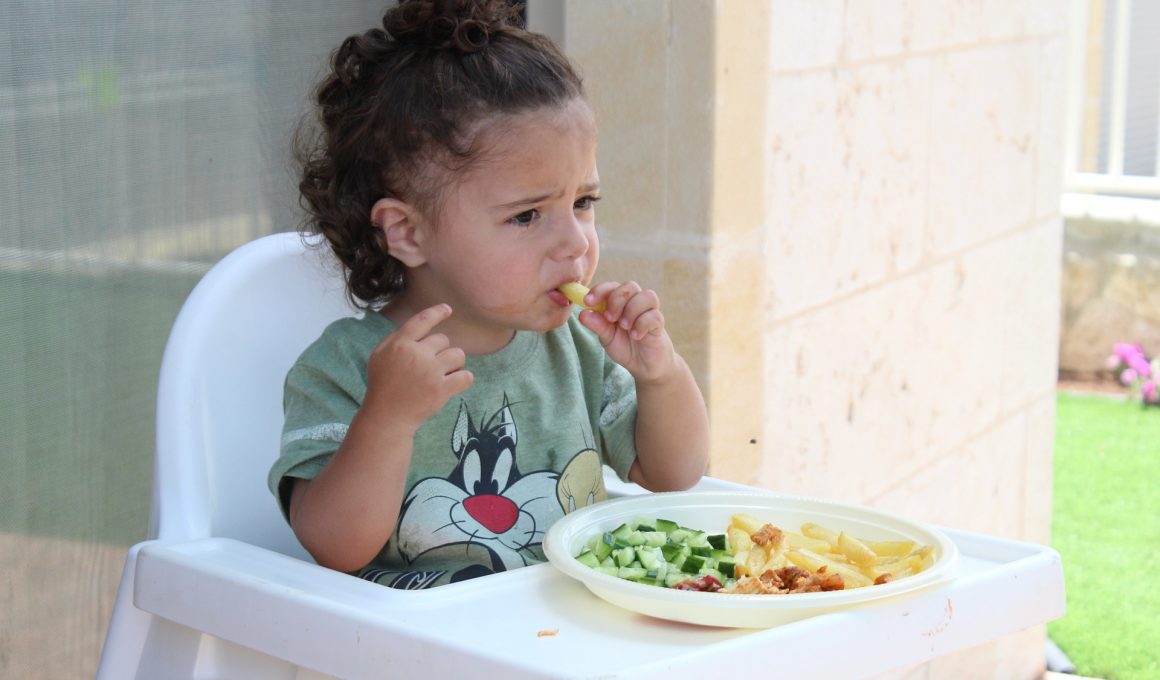Parents, we are all very familiar with the wild food mood swings our babies experience. You know… when your baby asks to eat something oddly specific, and you make the grocery run, cook the meal, set the table, bring them the food they very specifically asked for, and suddenly they never wanted any of it??
Yup, welcome to the woes of picky eaters’ parents. Picky eating is a term used to describe a child who consistently avoids certain foods or sticks to a narrow range of foods. Up to 50% of children are picky eaters. This is a common concern among parents, as they worry that their children may not be getting enough nutrition to support their growth.
According to experts, picky eating usually starts at age 2 or 3. This is the age at which toddlers begin experiencing autonomy and becoming independent thinkers. They engage in activities such as self-feeding, making their own choices, and deciding for themselves. Choosing what to eat is one of the many ways toddlers begin to express freedom, self-expression, and independence.
Table of Contents
- Is My Baby Ready For Solid Food?
- My Baby Hates Solid Food. Why?
- Understanding Your Baby’s Changing Appetite
- Tips For Your Baby Who Hates Solid Food
- Stay positive
- Model the behavior you want to see
- Involve your child in meal planning and preparation
- Enjoy family meals together
- Establish a routine
- Cook the same meals for all family members
- Don’t force your child to eat
- Start with small portions
- Introduce new foods with another food they like
- Make tasting a fun experience
- Don’t give up on a new food
Is My Baby Ready For Solid Food?
First, we will begin with whether your baby is ready for solid foods or not. Most babies start on solids around 6 months of age. However, this can vary from your baby to the next depending on their individual development.
Some signs that can help you with realizing that your baby is ready for solids are:
- Sitting Up With Minimal Support: Your baby should be able to sit up on their own or with little support, showing good head and neck control.
- Interest in Food: If your baby watches you eat with curiosity, reaches for your food, or opens their mouth when offered a spoonful, these are good signs they’re ready to explore solids.
- Loss of the Tongue-Thrust Reflex: This reflex causes babies to push food out of their mouths to prevent choking. By around 6 months, this reflex diminishes, making it easier for babies to swallow solids.
- Increased Appetite: If your baby seems unsatisfied with regular milk feedings and is waking up more frequently at night for feeds, they may be ready for the added nutrition that solids provide.
ALSO READ: What Age is Best to Start Solid Foods?
My Baby Hates Solid Food. Why?
Transitioning to solid foods is a significant milestone, but it’s not always smooth sailing. If your baby is resisting this change, there could be a variety of reasons behind their reluctance. Understanding these common causes can help you approach mealtimes with more empathy and less stress.
Some common reasons for why your baby might hate solid foods include:
Texture Sensitivity
Some babies are particularly sensitive to the texture of solid foods. They might find the feeling of mashed peas or pureed carrots unfamiliar and uncomfortable, leading them to reject the food. As babies explore solids, their taste and texture preferences are still developing, and it may take time for them to get used to different consistencies.
Teething Discomfort
Teething can make a baby’s gums sore and tender, making them less interested in chewing or swallowing solid foods. If your baby is teething, they might prefer softer or cooler foods that are gentler on their gums.
You may notice that they are more comfortable with breastmilk or formula during this time.
Developmental Readiness
Every baby is unique, and readiness for solids can vary widely. Some babies are eager to try new foods as early as 6 months, while others may need more time before they’re ready.
Pushing solids too early can lead to frustration for both you and your baby. Look for signs of readiness, such as showing interest in your food, being able to sit up with support, and losing the tongue-thrust reflex.
Preference for Familiarity
Babies are creatures of habit. If they’re accustomed to the taste and comfort of breastmilk or formula, the introduction of new foods can feel overwhelming.
It’s normal for babies to be cautious about trying new things, especially when it comes to unfamiliar tastes and textures.
Overwhelm and Stress
Mealtimes can be a sensory overload for some babies. The new environment, the pressure to eat, and the unfamiliarity of solid foods can make them feel anxious or stressed, leading to resistance.
A calm and relaxed atmosphere can help your baby feel more at ease during meals.
It’s important to remember that picky eating is a normal phase of development for many babies. As they grow, they may go through periods of rejecting certain foods or showing strong preferences. This phase doesn’t necessarily mean there’s a long-term issue—it’s often just a part of the learning process as they discover what they like and don’t like.
Understanding Your Baby’s Changing Appetite
ALSO READ: How to Introduce Solid Foods To Your Baby
Tips For Your Baby Who Hates Solid Food
Here are 11 expert tips about how to introduce new foods to your picky eater:
Stay positive
Negative thoughts and memories affect eating habits. As a parent, the more of a positive attitude you display regarding your child’s eating habits and don’t encode the the eating process as a conflict, the easier your picky eater child might develop healthy eating habits.
It is a process that takes time, but if done right and patiently, it is sure to bring about the results you want.
Model the behavior you want to see
Children learn and imitate behaviors by watching and listening to you. And when your child watches you, they learn how, when, and what to eat. Encourage your kids to experience, taste, and see different foods and flavors.
If there are some foods that you don’t enjoy but are healthy and beneficial for your child, try consuming them in front of your child. It is very beneficial for your child to know that you are learning to like the food.
You can model how to talk about the foods on your own plate, and even you can play with your own food to help your child engage with theirs.
Involve your child in meal planning and preparation
Involving your picky eater child in planning and preparing meals has many benefits. It helps with:
- Nurturing healthy eating habits
- Encouraging your child to try foods they helped to prepare
- Increasing their self-confidence
- Sharing cultural and family traditions
There are many ways you can go about this. For example, involving your child in meal planning can include:
- Taking your child shopping with you
- Looking up recipes together
- Giving them little cooking tasks (with appropriate supervision, of course) such as counting ingredients, picking fresh herbs from the garden, sifting, and stirring.
- Willingness to try new and different things.
ALSO READ: Dos and Don’ts for Baby’s First Foods
Enjoy family meals together
We know that parenting is a full-time job. And more often than not, parents do not have time to sit down together for a meal. Try increasing family meals. Sitting down with your child and eating together as a family.
Eating together has many benefits for both you and your child especially if they are a picky eater.
Some of these benefits are:
- It emphasizes the social aspect of eating.
- It allows time for family bonding and making memories.
- Mealtime is a great way to teach manners.
- It encourages conversation and communication.
- Family meals may promote trust between children and parents, which might be a key element in nurturing healthy eating.
- A trusting environment at the table helps your child establish a positive relationship with food and eating.
Establish a routine
Children enjoy routines because it provides them with a sense of security. Feeding schedules help your child develop regular patterns of appetite and ensure your child is well-nourished throughout the day.
In general, young children should have three meals and two to three snacks each day. A mealtime schedule might look like:
- Breakfast
- Mid-morning snack
- Lunch
- Mid-afternoon snack
- Dinner
- Bedtime snack
Make sure you serve meals and snacks around the same time every day. This will help establish a consistent routine.
Cook the same meals for all family members
At mealtime, having at least one food on the plate that you know your child will eat is helpful.
But be sure to give everyone at the table the same food.
Your child may not eat all the food on the plate, but if you have the same foods on your plate and eat them, you will set an example for your child.
Don’t force your child to eat
Encourage your child to try new foods, but don’t get into fights about it. This will make your child associate the experience of trying new foods with conflict.
A lot of us were raised to finish everything on our plates. But that is not a healthy habit to develop in your child. Do not force your child to finish everything on their plate. Force-feeding usually leads to poor eating habits. Hence, eating when not hungry or cleaning the plate when already full should not be encouraged.
If your child rejects the food, take the food away without saying anything. Try to stay calm, even if it’s very frustrating. You can try giving them the same food again at another time.
Start with small portions
A big portion might be scary for your child. Instead, start with small portions, and you can add more as your child familiarizes themselves with the new taste.
It is also important to praise your child even if they eat just a little and refrain from using dessert as a reward. Remember never to punish them for not eating or for eating less.
Introduce new foods with another food they like
Food pairing is a great way of introducing new foods to your picky eater. Take something they already like and present it with a new food you want to include in their diet, e.g., adding some broccoli alongside a plate of mashed potatoes.
Make tasting a fun experience
You should aim to make the experience of tasting new foods fun. Exploring new foods and different things should always be a fun experience. You can do so by making food look attractive and fun.
An easy way to do this would be to offer your child food in various colors, shapes, and sizes. Then leave the plate to your child as they experience new textures, shapes, flavors, colors, and sizes on their own.
Don’t give up on a new food
Researchers say introducing a new food should happen between 8 to 15 times before your child will accept it. Offer new foods to your child gently and frequently. At first, it may feel daunting but don’t give up.
Remember, slow and steady wins the race.
References: parents.com, healthychildren.org, health.clevelandclinic.org, www.nationwidechildrens.org, www.gosh.nhs.uk,










